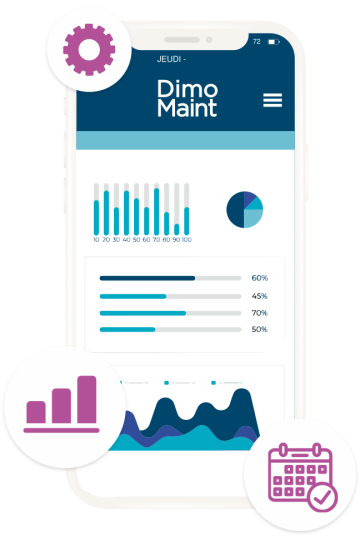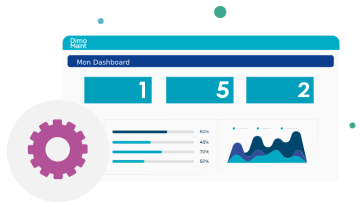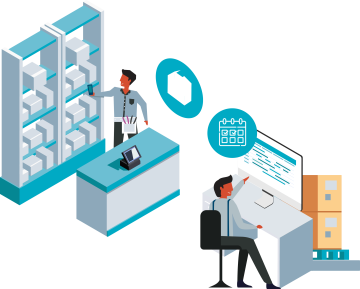The decision to choose between a Computer Aided Maintenance Management (CMMS) and an Enterprise Resource Planning (ERP) system is crucial for companies seeking efficiency in the management of their equipment, spare parts inventory, and maintenance processes. This article aims to guide you in this decision by highlighting the features, advantages, and disadvantages of each solution. The goal is to identify the option that perfectly aligns with the requirements of your maintenance management project. You will find practical tips for successfully integrating the selected solution, whether you choose an ERP project or the adoption of a CMMS software specifically designed for computer-aided maintenance.
Understanding the Fundamentals: CMMS and ERP Explained
What is a CMMS?
The CMMS has diversified beyond the industry, thanks to SaaS solutions. It extends to different sectors such as healthcare, energy, environment, transportation and logistics, and more to manage maintenance and related tasks. Its tools—strategic planning, smart inventory, mobility—enhance data analysis for increased productivity, notably by allowing real-time data access and entry.
The benefits of CMMS are significant: it reduces maintenance costs, extends the lifespan of equipment, optimizes procurement, and enhances employee safety. It also ensures regulatory compliance, proving indispensable for proactive and efficient maintenance management.
What is an ERP?
An ERP, or Enterprise Resource Planning, is an integrated system that drives a company’s activities, encompassing accounting, purchasing, project management, risk management, and supply chain. A comprehensive ERP suite can also include a performance management software, which is useful for planning and reporting financial performance.
By connecting business processes, ERP systems ensure a uniform flow of data. They act as the “single source of reliable information,” critical for comprehensive monitoring of manufacturing, logistics, and financial processes. ERPs are vital for the transparency of internal operations.
ERPs aim to enhance operational efficiency, simplify interdepartmental communication, and manage interactions with external entities. They minimize errors and support informed decision-making, establishing themselves as key elements in the optimization strategy of companies.
The Main Goals of Each Solution
On the other hand, ERP aspires to unify all essential business functions on a single platform. This includes finance, project management, human resources, and marketing, with the goal of merging these functions into a unified and streamlined system.
In conclusion, while a CMMS focuses on aspects of maintenance, an ERP embraces an integrated vision of operational management. Together, these technologies play a complementary essential role in improving and modernizing business management.
Criteria for Choosing Between CMMS and ERP
-
The specific needs of the company
Identifying whether the requirement is for a maintenance-focused solution or a system that encompasses overall management is critical. CMMS targets maintenance with precision, whereas ERP embraces a holistic view for process optimization.
Examining internal processes will help in choosing the system offering the best features for their needs. A company with numerous physical assets might lean towards a CMMS, while another wishing to improve integration and communication between its departments might prefer an ERP.
-
The size and structure of the organization
The size and configuration of the company are not decisive in the choice of the system. Smaller entities can indeed benefit from the simplicity and accessibility of a CMMS for maintenance. Larger entities, with a more complex organization in multi-sites and/or with an international presence, may also be drawn to the flexibility and economies of scale offered by a less cumbersome CMMS solution to deploy and manage.
However, the business process integration that ERP offers is a significant advantage for large organizations. The CMMS often extends ERP functionalities to maintenance processes.
The ease of adoption and the learning curve are, of course, criteria to consider. The specificity of the CMMS makes it easier for maintenance teams to adopt, while an ERP requires more extensive training due to its broader scope.
The CMMS would suit entities focused on maintenance. An ERP, on the contrary, is essential for those requiring coordination of various functions. The business process integration that ERP offers is a significant advantage for large companies.
-
The costs and the expected return on investment
Savings in terms of time and resources must also be considered. A CMMS can reduce maintenance expenses and extend the lifespan of equipment. An ERP, on the other hand, can improve and expedite market readiness.
-
Integration with existing systems
Integration with pre-existing technologies is critical. It is imperative that a CMMS can easily connect with the company’s other software systems, while an ERP is often chosen for its ability to consolidate all systems onto a single platform. Compatibility and ease of integration are key criteria for operational efficiency.
The flexibility of CMMS systems and ERPs in relation to existing infrastructures must be assessed. Successful integration ensures effective communication between departments and process optimization.
In conclusion, the support and updates provided by the supplier are fundamental. A system that adapts to the evolution of the company and integrates easily with new technologies represents an undeniable advantage.
CMMS vs ERP: Analysis of Advantages and Disadvantages
|
Criterion |
CMMS (Computer Aided Maintenance Management) |
ERP (Enterprise Resource Planning) |
|
Definition |
A software designed to optimize a company’s maintenance. |
An integrated system designed to drive a company’s activities, including accounting, purchasing, project management, risks, and supply chain. |
|
Objectives |
Maximize asset maintenance, optimize procurement, and increase material reliability and availability. Specifically focused on maintenance. |
Unify all essential business functions (finance, project management, HR, marketing) on a single platform for optimized management. |
|
Benefits |
– Reduced maintenance costs – Extended equipment lifespan – Optimized procurement – Regulatory compliance – Mobile accessibility and real-time data entry |
– Enhanced operational efficiency – Simplified interdepartmental communication – Managed interactions with external entities – Support for mobility, connectivity, and collaboration |
|
Disadvantages |
– Acquisition and deployment costs – Need for customization – Requirement of technical support – Learning time for team adoption |
– High initial and ongoing costs – Complexity of implementation – Need for harmonization with internal processes – Risk of additional costs if the chosen ERP is unsuitable |
Benefits of a CMMS
Its centralized information system accelerates the management of work orders and intervention requests, thereby strengthening decision-making strategies. Using data for in-depth analysis becomes a productivity driver. Moreover, its adaptability to various businesses and compatibility with different types of infrastructures make a maintenance software like CMMS a scalable tool.
Disadvantages of a CMMS
However, a CMMS is not without issues. Its acquisition and deployment can pose financial challenges, especially for SMEs. Customizing the software to meet specific requirements also demands additional time investments.
The lack of ongoing technical support, particularly from open source solutions, can lead to unforeseen expenses. Moreover, acclimatization to the software requires training, which can slow down its integration and adoption by teams.
Benefits of an ERP
ERP (Enterprise Resource Planning) solutions transform business management through effective integration and centralization of all operational processes. They ensure greater consistency and comprehensive visibility, thereby reducing information system costs and boosting productivity.
These systems adapt to dynamic digital requirements thanks to their support for mobility, connectivity, and their collaborative potential. They hold a central place in the digitalization of businesses, facilitating monitoring and revision of processes.
The ERP unifies data in a single database, automates recurrent activities, and refines the accuracy of information. This results in better decision-making supported by instant access to data.
Disadvantages of an ERP
Despite their benefits, ERPs involve significant initial and ongoing costs, though SaaS models can offer a more affordable alternative. Weighing these expenses against potential long-term gains is crucial, as ERPs can lead to substantial savings.
Their implementation is complex, requiring perfect alignment with the company’s internal processes, which can strain the budget and demand significant commitment in terms of resources and effort.
Choosing an unsuitable ERP can prove costly. Its setup is far from trivial and requires organization and diligence.
Conclusion
The decision to choose between a CMMS and an ERP is based on the goals your company seeks to achieve. If a CMMS is designed to perfect maintenance, an ERP unifies all business activities.
Take into account various elements to make your choice: the specific requirements of your company, its size, financial implications, and compatibility with your existing systems. Remember, the perspective behind adopting such a solution is to promote operational efficiency and to engage in a digital transformation initiative.
Take the time to carefully analyze your options. Then commit to the solution that not only meets your current needs but is also capable of propelling your company towards new horizons.








